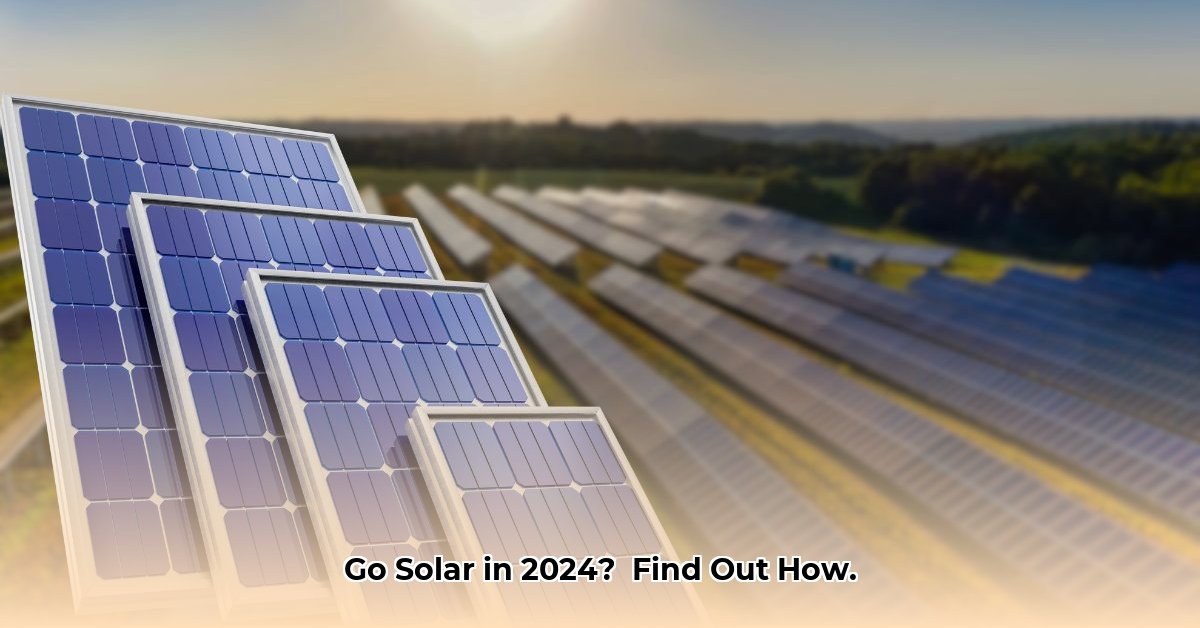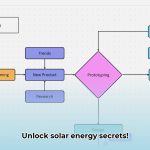Considering solar power for your home? This comprehensive guide provides a clear and detailed overview to help you determine if it’s the right investment. We’ll delve into assessing your energy needs, selecting a top-notch installer, understanding diverse financing options, navigating the installation process, and ensuring long-term system performance. Let’s explore the world of residential solar power and see if it aligns with your specific needs. For more information on different solar energy types, check out this helpful resource: Solar Energy Types.
Quantifying Your Energy Needs and Evaluating Roof Suitability for Solar Panels
Prior to committing to solar panels, a thorough understanding of your energy consumption is crucial. Scrutinize your electricity bills from the past 12 months to establish your average monthly usage in kilowatt-hours (kWh). This figure serves as the foundation for determining the appropriate solar system size.
Next, conduct a meticulous evaluation of your roof’s suitability. A south-facing roof (in the Northern Hemisphere) is generally considered optimal, as it captures the most direct sunlight throughout the day. However, east- and west-facing roofs can also be viable options, albeit with potentially lower energy production.
Several factors contribute to roof suitability:
- Orientation: South-facing roofs are best, but east and west can work.
- Angle: A roof pitch between 15 and 40 degrees is often ideal.
- Shading: Minimize shading from trees, chimneys, or nearby structures.
- Size: Ensure sufficient surface area to accommodate the required number of panels.
- Condition: Assess the roof’s age and structural integrity; a roof nearing the end of its lifespan may need replacement before solar installation. Consult a roofing professional for an inspection.
Consider using online solar calculators to estimate potential energy production based on your location, roof characteristics, and system size.
Selecting a Reputable Solar Installer: Due Diligence for a Successful Project
Choosing the right installer is paramount for a seamless and successful solar project. Obtain at least five quotes from reputable, licensed, and insured companies in your area. Thoroughly vet each installer by:
- Checking online reviews: Explore platforms like the Better Business Bureau, Google Reviews, and SolarReviews for feedback from previous customers.
- Requesting references: Contact past clients to inquire about their experiences, workmanship quality, communication, and problem-solving abilities.
- Verifying licenses and insurance: Ensure the installer holds the necessary licenses and insurance coverage to operate in your jurisdiction.
- Reviewing warranties: Carefully examine warranties on both the equipment (panels, inverters) and the installation workmanship. Understand the terms, duration, and coverage details.
- Assessing experience: Prioritize installers with a proven track record and extensive experience in residential solar installations.
Prepare a list of questions to ask potential installers, including:
- What panel brands and models do you offer, and what are their performance specifications?
- What is the estimated lifespan of the system and its components?
- How long have you been in business?
- Can you provide examples of similar installations you’ve completed?
- What permits are required, and who is responsible for obtaining them?
- What is your installation process, and how long will it take?
- Do you offer post-installation monitoring and maintenance services?
- What is your process for addressing any issues or concerns that may arise after installation?
Demystifying Financing Options: Ownership vs. Third-Party Agreements
Residential solar projects offer a range of financing options, each with its own advantages and disadvantages. Select the option that best aligns with your financial situation and long-term goals.
- Cash Purchase: Paying cash upfront provides immediate ownership of the system and eliminates interest payments. This option yields the greatest long-term savings but requires a significant initial investment.
- Solar Loans: Securing a solar loan allows you to finance the system over a specified period, typically with monthly payments. Interest rates and loan terms vary, so shop around for the best deal. While this reduces the upfront cost, you’ll pay more over the life of the loan.
- Power Purchase Agreements (PPAs): A PPA allows you to purchase electricity generated by a solar system installed on your roof, owned and maintained by a third-party company. You pay a fixed rate per kilowatt-hour (kWh) of electricity, often lower than your utility’s rate. You don’t own the system, so you’re not eligible for tax credits or rebates.
- Solar Leases: Similar to a PPA, a solar lease involves renting a solar system from a third-party company. You pay a fixed monthly fee for the use of the system, regardless of how much electricity it generates. As with PPAs, you don’t own the system and are not eligible for incentives.
Carefully evaluate the financial implications of each option, considering factors like:
- Upfront costs
- Monthly payments
- Interest rates
- Loan terms
- Eligibility for tax credits and rebates
- Long-term savings potential
- Ownership of the system
- Responsibility for maintenance and repairs
Navigating the Installation Process: Permits, Inspections, and Timelines
Once you’ve chosen an installer and financing option, the installation process commences. This typically involves:
- Permitting: Obtaining necessary permits from local authorities is a crucial step. Permitting requirements and timelines vary by jurisdiction, so be prepared for paperwork and potential delays. Your installer should handle the permitting process, but stay informed and proactive.
- Scheduling: Coordinate the installation date with your installer, considering weather conditions and your availability.
- Installation: The installation itself can take anywhere from one to several days, depending on the system’s size and complexity. Expect some disruptions during the process, such as noise and roof access.
- Inspections: After installation, a local building inspector will examine the system to ensure it meets safety and code requirements.
- Interconnection: Finally, the system must be connected to the utility grid, allowing you to send excess energy back to the grid and receive credit on your bill.
Anticipate potential challenges during the installation process, such as:
- Weather delays
- Permitting delays
- Unexpected roof issues
- Equipment availability
Monitoring and Maintaining Your Solar System: Ensuring Long-Term Reliability
Your responsibility extends beyond installation. Regular monitoring and maintenance are essential for ensuring optimal system performance and longevity.
- Monitoring: Many systems feature online monitoring dashboards that allow you to track energy production, identify potential problems, and compare energy use across different time periods. Regularly review your system’s performance data.
- Cleaning: Dust, dirt, and debris can accumulate on the panels, reducing their efficiency. Clean your panels periodically, either yourself (with appropriate safety precautions) or by hiring a professional cleaning service. How often depends on your environment, but typically 2-4 times per year is sufficient.
- Inspections: Consider scheduling annual professional maintenance inspections to identify any potential issues, such as loose wiring, damaged panels, or inverter problems.
- Repairs: In the event of system malfunctions, contact your installer or a qualified solar technician for repairs.
Weighing the Pros and Cons: Is Solar Right for You?
Residential solar power offers a compelling value proposition, but it’s important to consider both the advantages and disadvantages before making a decision.
Pros:
- Reduced Electricity Bills: Significantly lower or even eliminate your monthly electricity bills, saving you money over the long term.
- Increased Home Value: Studies show that solar panels can increase home value, making your property more attractive to potential buyers.
- Environmental Benefits: Reduce your carbon footprint and contribute to a cleaner, more sustainable environment.
- Tax Credits and Incentives: Take advantage of federal, state, and local tax credits, rebates, and other incentives to lower the initial cost of the system.
- Energy Independence: Gain greater control over your energy supply and reduce your reliance on the utility grid.
- Long-Term Investment: Solar panels are a long-term investment with a lifespan of 25 years or more.
Cons:
- Upfront Costs: The initial cost of a solar system can be substantial, although financing options and incentives can help mitigate this.
- Dependence on Sunlight: Solar panel output depends on sunlight, meaning that energy production can fluctuate based on weather conditions and time of day.
- Roof Suitability: Not all roofs are suitable for solar panels due to orientation, shading, or structural limitations.
- System Malfunctions: While rare, system malfunctions can occur, requiring repairs and potentially interrupting energy production.
- Regulatory Complexities: Navigating permitting requirements, net metering policies, and other regulations can be complex and time-consuming.
Navigating Incentives and Regulations: Maximizing Savings and Ensuring Compliance
Research available federal, state, and local government incentives to reduce the upfront costs of your solar installation. The federal Investment Tax Credit (ITC) currently offers a tax credit equal to 30% of the system’s cost. Many states and local governments offer additional rebates, tax credits, or grants.
Regulations governing solar installations, permitting, inspections, and net metering policies vary by location. Check with your local authorities to understand these rules and ensure compliance.
Net metering policies determine how you are credited for excess energy that you send back to the grid. Favorable net metering policies can significantly improve the financial return on your solar investment.
The Future of Residential Solar Power: Technological Advancements and Emerging Trends
The field of solar energy is constantly evolving, with ongoing advancements in technology and emerging trends that promise to further enhance the efficiency, affordability, and accessibility of residential solar power.
- Battery Storage: Battery storage technology is rapidly improving, allowing homeowners to store excess solar energy for use at night or during power outages. This enhances energy independence and resilience.
- Smart Inverters: Smart inverters offer advanced features such as grid support, voltage regulation, and remote monitoring, further optimizing system performance.
- High-Efficiency Panels: Manufacturers are continuously developing more efficient solar panels that generate more electricity from the same amount of sunlight.
- Integrated Solar Roofing: Solar shingles and integrated solar roofing systems offer a more aesthetically pleasing alternative to traditional solar panels.
Stay informed about these advancements, as they can impact future upgrades or enhancements to your solar system.
Choosing residential solar power is a significant investment that can provide long-term financial and environmental benefits. By conducting thorough planning, careful research, and appropriate financing, you can ensure the success of your project and enjoy the benefits of clean, renewable energy for years to come.
Making Solar Accessible: Financing Options for Homeowners with Low Credit Scores
Going solar is smart, but what if your credit score isn’t perfect? This guide breaks down financing options for how to finance residential solar panel installation with low credit score.
Assessing Your Solar Needs and Roof Suitability
Assess your home’s energy use and have a professional solar assessment to determine your system’s size, factoring in your roof’s orientation, shading, and structural integrity. What are the key factors in assessing roof suitability?
Finding a Reputable Solar Installer
Find a trustworthy installer by getting multiple quotes, checking licenses and insurance, and ensuring a strong warranty. Look for reviews and referrals. Why is it critical to verify installer credentials?
Understanding Your Solar Financing Options for Low Credit Scores
Traditional loans require good credit. Alternative options include:
- Power Purchase Agreements (PPAs): Buy the electricity generated by panels you don’t own.
- Solar Leases: Pay a monthly fee without ownership.
- Property Assessed Clean Energy (PACE) Financing: The loan is secured by your property.
- Low-Credit Loans: Expect higher interest rates from specialized lenders.
- Government Incentives: Federal tax credits (currently 30%) reduce upfront costs.
What are the key differences between PPAs and solar leases?
Navigating the Installation Process
The installation process involves obtaining permits, system installation, and inspections. Maintain clear communication with your installer.
Monitoring and Maintaining Your Solar System
Regular monitoring and maintenance maximize efficiency and lifespan. Follow your installer’s maintenance schedules.
South-Facing Solar: Installation Guide for Maximum Efficiency
- South-facing roofs are ideal for maximizing sun exposure
- Planning is crucial for system design and code compliance
- Reputable installers are key
- Financing options suit individual budgets
- Maintenance ensures long-term efficiency
South-facing roofs are ideal for Residential Solar Panel Installation for South-Facing Roofs, maximizing sunlight and energy generation. Let’s explore how to make this project successful.
Assessing Your Energy Needs and Roof Suitability
Figure out your energy usage by reviewing past electricity bills. Is your roof south-facing and structurally sound? How much unshaded space is available? What are the benefits of south-facing roof for solar panel systems?
Next, consider local incentives by checking your local government website.
Finding and Vetting a Solar Installer
Research local installers thoroughly, check online reviews, ask for references, and confirm licensing and insurance. Get multiple quotes, comparing system design, warranties, and reputation. How does an installer’s reputation influence the project outcome?
Understanding Solar Financing Options
Various options exist beyond paying cash, including loans, Power Purchase Agreements (PPAs), and leasing arrangements. Weigh the pros and cons, considering interest rates, long-term costs, and ownership.
Navigating the Installation Process
Obtain necessary permits from your local authorities. Your installer handles permitting, but provide required information. The installation can take days or weeks, depending on system size and complexity. Adhere to building codes, regarding firefighter access and structural integrity. What code requirements are crucial for solar panel safety?
System Monitoring and Maintenance
Regular system monitoring is vital using online dashboards to track energy production and consumption.
Schedule annual maintenance inspections to ensure everything’s running optimally. Clean panels efficiently capture sunlight. What are the key elements of a preventative maintenance plan?
Optimizing Residential Solar Power Systems in Shaded Environments
- Shade reduces solar panel efficiency
- Shade-tolerant panels improve performance
- Panel placement and orientation are crucial
- Regular cleaning maximizes output
- Financing options are essential
- System maintenance ensures performance
Optimizing Residential Solar Power Systems in Shaded Environments is entirely possible. This guide walks you through the process.
Assessing Your Energy Needs and Roof Suitability
Understand your home’s energy usage and evaluate your roof. How much shade does it receive throughout the day? Detailed roof analysis is critical.
Choosing the Right Solar Panels: Shade Tolerance is Key
Shade-tolerant panels mitigate the issue using sophisticated bypass diodes, allowing current to bypass shaded cells and limit energy loss, improving performance in partial shade. What are the advantages of shade-tolerant panels?
Finding and Vetting a Reputable Installer
Get multiple quotes, comparing guarantees, warranties, and experience with installations in shaded environments. Verify licenses and insurance. What qualities define a qualified installer for shaded environments?
Understanding Your Financing Options: Cash, Loans, or Leasing?
A cash purchase provides complete ownership. Loans offer manageable monthly payments. Power Purchase Agreements (PPAs) and leasing allow you to use solar energy without upfront costs.
Navigating the Installation Process: Permits and Timelines
Obtain the necessary permits. Get a clear timeline outlining the installation phases.
Monitoring and Maintaining Your System
After installation, consistent monitoring ensures optimal performance. Regularly check your system’s output to identify any problems early. Cleaning your panels is important; dust and debris reduce efficiency.
Maximizing Your Return on Investment: Strategic Panel Placement
- Analyze Shading Patterns: Observe your roof throughout the day; note the times and duration of shade.
- Prioritize Sun Exposure: Place panels where they receive maximum sunlight.
- Utilize Shade-Tolerant Panels: These panels perform better in partially shaded areas.
- Optimal Panel Orientation: Generally, south-facing (Northern Hemisphere) maximizes energy generation.
- Potential Solutions: Consider adjusting tree branches or other vegetation casting shadows, If practical.
- Wind Energy Powered Cars: Are They the Future of Driving? - December 3, 2025
- Wind Energy in Cars: Is This the Future? - November 30, 2025
- Wind Energy For Residential: Is It Right For Your Home? - November 28, 2025
















